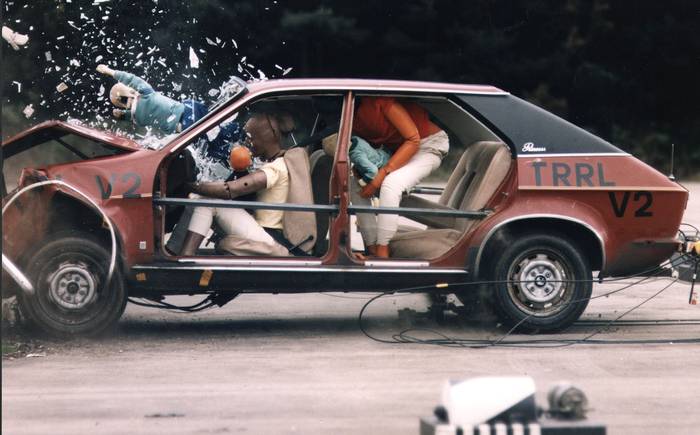How safe is my car?
And what Euro NCAP results mean for you

CAR SAFETY has come on in leaps and bounds since the days of wooden steering wheels, bench seating and lap belts. Car makers have embraced the notion of advanced vehicle safety by working with the European new car assessment programme (Euro NCAP).
Search for and buy your next car on driving.co.uk
Established in 1997, Euro NCAP tests new vehicles in four major areas: adult occupant protection, child occupant protection, pedestrian protection and safety assist. Before 2009, the first three areas only were tested and all three categories were handed a star rating out of five.
The accelerating popularity of Electronic Stability Control, seatbelt reminders and speed limitation devices (that automatically keep speeds below the road’s maximum) prompted the addition of a Safety Assist test and now all test results are combined and expressed as an overall rating out of five. Importantly, the car’s test result in each area continues to be given.
Car crash tests explained
Frontal impact test
A car travelling at 40mph strikes a deformable barrier that is offset to the driver’s side. Readings are taken from dummies located in the front two seats to examine the protection of limbs, chest and head. The test is designed to simulate the most frequent type of road crash (one car striking another of similar mass, head-on) resulting in serious or fatal injury. Whiplash is also considered here, by measuring the size and shape of head restraints and their dynamic performance during the crash. Airbags, multi-stage airbags, the removal of hazardous structures around the legs and knees, and intrusion reduction in the footwells are all key injury-reduction measures and techniques for this test.
Car to car side impact test
A mobile deformable barrier strikes the driver’s door at 31mph while the car is stationary. Although not a true simulation of a ‘T-Bone’ impact commonly experienced at junctions, it gives a good indication of the level of protection provided from intrusion into the driver’s side.
Pole side impact test
According to Euro NCAP, a quarter of all serious-to-fatal accidents happen in side-impact collisions in Europe. Many of these occur when the vehicle strikes a pole or a tree. In the pole side-impact test the car is propelled sideways at 18mph into a fixed pole. Side impact or curtain airbags help to protect the head and upper torso, while cars with minimal pole intrusion will also score high marks.
Child and pedestrian protection test
The advent of ISOFIX mountings for child seats has improved child safety in cars but Euro NCAP still runs separate tests for children in its frontal and side-impact simulations. Dummies representing 18-month and three-year-old occupants are placed in the rear of the car in the type of child restraint recommended by the vehicle’s manufacturer. The score is determined by the child seat’s performance during the tests and also on the fitting instructions for the child restraints, provision of airbag warning labels and the car’s ability to accommodate the child restraints safely.
Pedestrian safety is one of the most difficult aspects to judge as it is impossible to control where a test dummy’s head will strike the bonnet of the car. Instead, individual dummy components – a limb, the head and the chest – are tested against separate areas of the car’s front. Tests have found that protection can be improved with pedestrian-friendly bumpers and by removing unnecessarily stiff structures.
Safety assist test
This relatively new test is a result of Euro NCAP’s support for Electronic Stability Controls on modern cars. A new car will gain three Safety Assist points if ESC is fitted as standard. The test simulates a double-lane change at 50mph using sudden steering-wheel rotations. The car must be able to avoid an obstacle within one of the lanes and remain stable after the emergency manoeuvre has been carried out. Seat belt reminders and speed limitation devices are also rewarded.
What Euro NCAP results mean for drivers
What if the car of your dreams has a low Euro NCAP rating? Don’t panic: the vehicle type is as relevant here as the safety features it may have. A roadster will rarely achieve five stars because its low-slung design makes it difficult to achieve a good pedestrian safety score. Pick-up trucks have a bad habit of flattening anyone who stands in their path and until recently, have struggled to consistently perform well in the child occupant simulations. (Saying that, the 2012 Ford Ranger was the first pick-up in its class to achieve the coveted five-star rating, even collecting an 81% score for pedestrian safety and an impressive 86% for child occupant safety.)
The website (euroncap.com) has all the latest results, along with previous tests run before 2009, but be warned: delving into their gory details can be disturbing. A sketched crash test dummy illustrates exactly which body part gets mangled most during an accident while diagrams highlight the areas of the bonnet and windscreen that are most likely to skewer a pedestrian.
A bit of gory bedtime reading is well worth it, though. As cars continue to get safer and technology is geared towards human preservation, the five-star classification will become commonplace. It pays to research that area of vehicle safety of most concern to you. Both the new Hyundai i30 and the Citroën DS4 have five Euro NCAP safety stars yet the i30 scored 90% for child protection over the DS4’s 80%. The Citroën struggled to perform when an 18-month-old child is facing rearward in the front passenger seat.
As ever, it’s down to personal requirements. Families on the lookout for a safe vehicle to transport children should definitely visit euroncap.com and weigh up their options but those looking for some weekend fun shouldn’t be disheartened at four stars.




